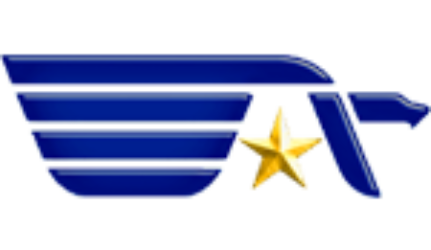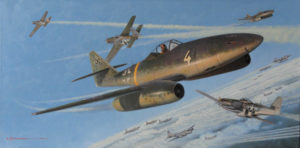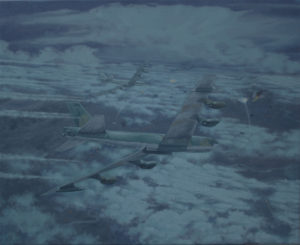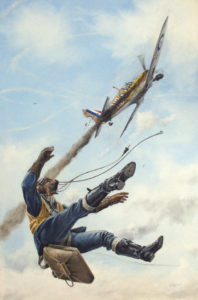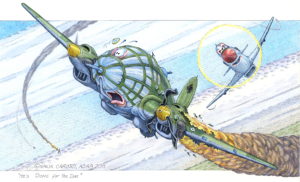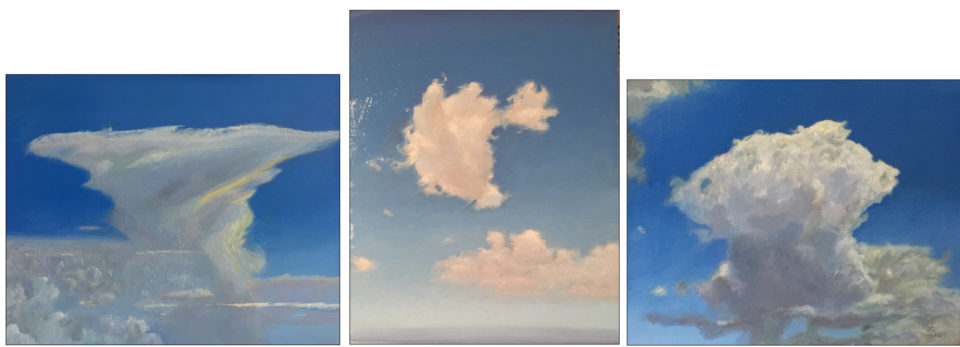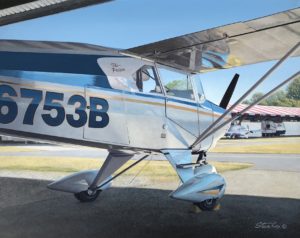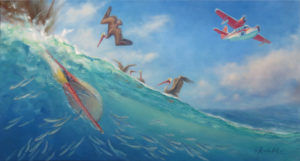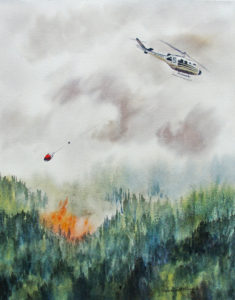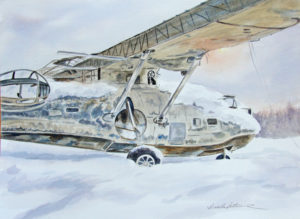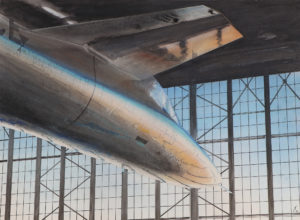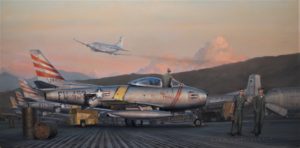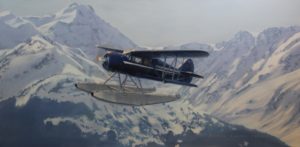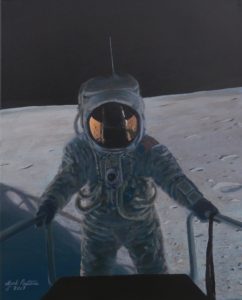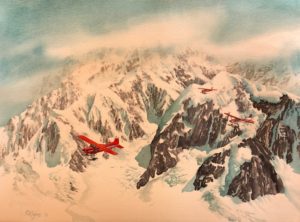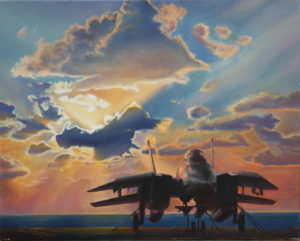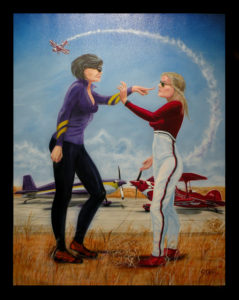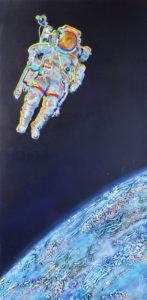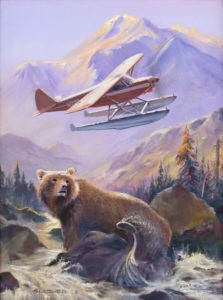2018 ASAA International Aerospace Art Exhibit
The American Society of Aviation Artists (ASAA) International juried art exhibition, featuring 38 works by 25 different artists from around the world, is on displayed in the Palm Springs Air & Space Museum, Palm Springs, California April 22 — July 31, 2018
Robert Aikins
“Bugatti”
17” x 33” Oil
To many, Bugatti means automotive royalty. Yet, few are aware of Bugatti’s efforts with an aircraft known as the Model 100. Louis deMonge was hired by Bugatti to design an all-wood speed-record aircraft capable of surpassing the German record held in 1939 at 469 mph. Never flown, it remained in France until some 40 years later when it was moved to the USA. This painting tries to capture the beauty of the Model 100 as it might have appeared in 1940, ready to compete.
Robert Aikins
“Search & Rescue”
16” X 40” Oil
The Canadian Armed Forces Search and Rescue operations began to task airplane resources in 1945. The De Havilland Canada DHC-3 Otter and the Beech C-45H Expeditor are two workhorses that saw service with the RCAF in the search and rescue role.
Steve Anderson
“Wounded Bird”
14” x 18” Oil
On May 15th, 1918, Capt. Charles Biddle of the 103rd Aero Squadron, USAS, engaged a German Junkers J.I flying low over the trenches. Biddle tried to get into the slow moving Junkers’ blind spot by flying beneath it, but he overshot and wound up too close to bring his gun to bear. In Biddle’s words, “I saw a black-helmeted head appear over the edge of the Hun machine and almost at the same instant he fired, as quickly as you could snap-shoot with a pistol…” Biddle was hit in the knee, his Spad VII was hit in the motor, which stopped, and he crash-landed in no-man’s land. He managed to make it to the British trenches and recovered in the hospital. Biddle would go on to add five more victories to his tally for a total of seven by war’s end.
Steve Anderson
“First Encounters”
18” x 36” Oil
“I made my first test flight in the Me-262 in June of 1944…It gave me a wonderful feeling of effortless speed and power.” Armed with a quartet of 30 mm cannon in the nose and speed in excess of 500 mph, the Messerschmitt Me-262 proved to be a formidable opponent. In the Fall of 1944 the 262 pilots started to gain some momentum while test flying and evolving combat tactics for the best way to use the advantages of the Me-262 for attacking heavy bombers. First encounters with the new jet by escort fighters were hit-and-miss as the Allied pilots tried to counter the threat. One pilot was heard to say, “My God, what was that?”
Brian Bateman
“From the Fence to the Rabbit Hole”
24” x 30” Oil
“Wine 2”, a B-52G based out of Anderson AFB in Guam with Howard Butcher as lead pilot in Wave 1, turns from the “Fence” (the Laos Cambodian border) banking to line up on the bomb run to drop their payload over the “Rabbit Hole” (IP) at the Thai Nguyen rail yard on the 26th of December during operation Linebacker II. These missions were long, about 12-14 hours from Guam, and harrowing over the target as SAMS (rattlesnakes) were launched as well as flak. Several losses occurred this night as well as the nights to come, though soon these missions would bring the Vietcong to the peace talks in Paris, ending the war.
Robert Brun
“Baleout”
30” x 20” Oil
During the Battle of Britain, many RAF pilots lost their “kites” in combat with the Luftwaffe. Pilots develop an emotional bond with the inanimate aircraft that has seen them safely through dangerous sorties, which defies rationale. The sense of loss experienced when said aircraft is destroyed is often in immediate contrast to the sense of relief that he has survived to fight another day.
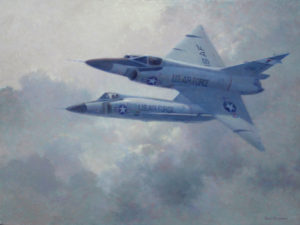
Paul Burrows
“Pair of Deuces”
18” x 24” Oil
This painting shows a flight of two F102s out of Perrin AFB, Texas on a training sortie sometime in the ‘60s. Having found a reasonably clear area in which to “bump heads” the flight is breaking up to obtain separation. Perrin closed decades ago and is now North Texas Regional Airport.
Hank Caruso
“Double Ugly”
10” x 14”
Ink & Prismacolor
The F-4 Phantom II was better know as “Rhino” because of its hulking mass, thick hide, and Don’t-Get-In-My-Way attitude. It was crewed by two aviators: the pilot in front, who lit the engines and pointed the aircraft nose in the general direction of where it needed to go, and the back-seater (RIO—Radar Intercept Officer—in the Navy/Marine Corps or WSO—Weapon Systems Operator—in the Air Force), who operated the sensor and weapon systems, monitored the general health of the aircraft, and provided adult supervision for the Rhino in front.
Hank Caruso
“He’s Done for the Day”
11” x 14”
Ink & Prismacolor
The Heinkel He-111 was a workhorse medium bomber of the German Luftwaffe in World War II.
Unfortunately, it continued to be used in front-line service long after it reached its performance prime. By the middle of the war, it was no match for Allied fighter defenses, like the North American P-51 Mustang, the aggressor in this Aerocature. Bombing became a secondary mission for the Heinkel, which flew more hours as an aerial supply transport, glider tug, and night fighter. (This Aerocature is devoted to the memory of our friend, the late Greg Weber, who provided the inspiration for this art.)

Douglas Castleman
“Gemini-Titan”
24” x 12” Oil
The launch of the next-to-last Gemini mission, on Sept. 12, 1966, putting Pete Conrad and Dick Gordon into orbit.
John Clark
“Cloud Study Triptych”
8×10 Oil
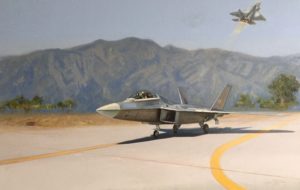
John Clark
“F-22”
Oil

Steve Cox
“Starfighters”
24” x 36” Acrylic
In 1959 most USAF fighters were still allowed to carry colorful markings. Here, the Commanding Officer of the 436th TFS of the 479th TFW is leading a group of Lockheed F-104C Starfighters through some close formation training at contrail altitude. As a kid, I thought the Starfighter was the most astounding, futuristic fighter design I had ever seen. I still think it was the most beautiful fighter ever built.[/column]
Steve Cox
“TriPacer”
16” x 20” Acrylic
One beautiful Saturday morning I was wandering around the local air patch (Harvey Field, Snohomish WA.) and was pleased to come across this very clean, nicely painted Piper TriPacer. I’ve had a fascination with TriPacers every since I built the Monogram plastic kit as a kid. It came complete with a victorious hunter posing with his foot on a vanquished mountain lion. Not very PC, but in the ” Leave it to Beaver ” days it was way cool.

T.J. Cronley
“Three Guys and a Harrier”
27” x 26” Oil
The artist’s three sons gather around an AV-8B Harrier’s ordnance pylons (including a Sidewinder rail!) at a squadron family event in 1988.
T.J. Cronley
“Woody’s Pusher”
24” x 30” Oil
Aeronautical engineer Harris Woods designed and built his Woody’s Pusher in the mid 1960’s. He sold plans, and this nifty parasol design became quite popular. The artist owned one. Tandem seating, Pusher prop, super visibility, and, as Mr. Woods emphasized, fun!
Don DeGaspari
“Orion on Sunrise Patrol “
35” x 48” Watercolor
A Lockheed P-3C “Orion” of VP-23 “Seahawks”, based at Brunswick, ME (1960-70), is depicted “On Loiter”, with the outboard engines shut-down and propellers “feathered” to conserve fuel.
Thomas Duntemann
“Wildcat at the Cow Pasture”
14” x 21” Watercolor
“Wildcat at the Cow Pasture” is an homage to the Navy, Marine and Army aviators and their support at Guadalcanal. It is a composite of a study I painted of the Wildcat at the Military Aviation Museum in VA, a photo I took of a derelict control tower on Guadalcanal in 1989 and archive photos of aircraft taxiing by the same tower. The Cow Pasture was the Fighter Strip near Henderson Field, built to accommodate the fighters as Henderson Field took on the larger aircraft. The P-38 dates it to late 1942 or early 1943.
Kristin Hill
“Splash – In!”
16” x 30” Oil
The Grumman Goose earned a respected and nostalgic place in the history of air service to delightful island destinations. This painting captures the amphibious Goose powered by throaty radial engines sharing the beautiful salt waters with the intrepid diving pelicans of Catalina Island.
Greg Jackson
“Waco Red”
20” x 16” Acrylic
I saw this beautiful red Waco biplane on the grass strip at the Military Aviation Museum in Virginia Beach, VA.
Greg Jackson
“H-1 Racer”
14” x 36” Acrylic
On January 19, 1937, Howard Hughes set a transcontinental speed record in this aircraft, flying from Los Angeles to New York City in 7 hours and 28 minutes. With innovations like flush rivets and retractable landing gear, the H-1 was a groundbreaking design.
Priscilla Messner-Patterson
“Fire Ops at Little Cranberry Lake “
12.5” x 10” Watercolor
A Washington State Department of Natural Resources helicopter was part of a firefighting crew during the week of August 25-30, 2016 in the area of Little Cranberry Lake near Anacortes, Washington. No lives or personal properties were lost and the area was reopened to visitor use in the spring of 2017.
Priscilla Messner-Patterson
“The Ghost of Dago Lake”
9” x 12” Watercolor
In 1947 a PBY5A made an emergency landing at Dago Lake on the Alaska Peninsula 330 miles southwest of Anchorage. There were no injuries to the crew, but the aircraft sustained substantial damage. She remained there until being rescued by the Alaska Aviation Heritage Museum in 1984. Her ghostly presence as part of the museum’s collection creates an almost monochromatic image in Alaska’s soft winter light.
Crissie Murphy
“Warrior”
7” x 5” Acrylic and Gold Leaf
A USAF Senior Airman deep in contemplation at Patriot Defender Training, Ft. Wolters, Texas.
John Nicklin
“Vigil Eye: Mach 3 Calling”
14” x 19” Mixed Media
‘Vigil Eye: Mach 3 calling’ is an illustration inspired by a visit to the Air Force Museum Annex in October 2011. The North American XB-70 seems ahead of its time; poised for yet another flight if only the hanger doors would open, sunny skies and fair weather ahead, cleared for take off – our imagination invites.
Darby Perrin
“The Pirate of Suwon”
20” x 40” Oil
The base was originally established during the Korean War as Suwon (K-13) Air Base and hosted the 36th Fighter Bomber Squadron. The base was used for the staging of F-86 patrols along the Yalu River and MiG Alley.
Darby Perrin
“Dillingham Sparkle”
24” x 48” Oil
This 1934 WACO YKC Seaplane currently resides in the Alaska Aviation Heritage Museum. The painted image reflects the glory days that it knew once before, ferrying passengers throughout southern Alaska.
[/column][column col=”2/3″]
Mark Pestana
“Apollo 16: Duke Family Portrait“
12” x 24” Acrylic
Apollo 16 Lunar Module Pilot USAF Brig Gen Charles M. Duke left his family portrait on the Moon’s surface in April 1972.
Mark Pestana
“The Moonwalker”
20” x 16” Acrylic
During the Apollo Program six missions successfully landed on the Moon. About to descend the Lunar Module lander is one of the twelve men who walked the lunar surface. In order of their first step on the Moon are: Neil Armstrong, Buzz Aldrin, Pete Conrad, Alan Bean, Alan Shepard, Edgar Mitchell, David Scott, James Irwin, John Young, Charles Duke, Eugene Cernan, and Harrison Schmitt.
Marcus Poole
“Remembrance”
10” x 8” Oil
This was a painting that began en plein air at the National WWII Museum’s 2017 Air, Sea, and Land Festival in New Orleans, Louisiana. The aircraft is of John Mosley’s recently-restored TBM-3 Avenger that is painted in the markings of the aircraft flown by Vicksburg, Mississippi’s Guy McAdory Brown, Jr. Brown flew with VT-85 from the USS Shangri-La, and was killed in action on July 28, 1945, attacking shipping in Kure Harbor, Japan. What would the Wright Brothers think of man traveling to the Moon?
Marcus Poole
“Squawkin’ Hawk Departing Thorpe Abbotts”
20” x 32” Oil
B-17F 42-30088 “Squawkin’ Hawk” of the 100th Bomb Group takes off for an early morning mission from Thorpe Abbotts airfield in England in July, 1943. “Squawkin’ Hawk” was an original ship of the 100th BG, which had begun flying combat missions in June 1943. It had originally been assigned to the Sumner Reeder crew, and they flew their first twelve missions aboard the ship. “Squawkin’ Hawk” was the first ship in the 100th BG to complete 50 missions, at which point it was returned to the the US for a War Bonds tour. This painting was done for the ship’s original navigator, Russell En.
Cher Pruys
“Daybreak“
10.75” x 14” Acrylic
Day breaks at the air base where the Beech 18’s are lined up ready to fly the fishermen to remote locations in the north country.
Cher Pruys
“Fall Splendour”
10.25” x 14” Acrylic
This Beech 18 catches the reflections of the surrounding fall foliage; truly a glimpse of fall’s splendour.
Sharon Rajnus
“Denali Trio”
22” x 30” Watercolor
Sightseeing Denali (Alaska) has long been a popular flight. The mountain is so massive it produces its own weather, so clear days are at a premium. Denali encompasses six million acres of Alaska’s interior wilderness and at 20,310 feet high, is North America’s tallest peak.
David Rawlins
“Martin B-10s of the 31st Bombardment Squadron”
24” x 48” Mixed
The Martin B-10 was introduced in 1934, and was faster than any of the biplane fighters then in service with the United States Army Air Corps. The B-10 featured all-metal construction, an internal bomb bay, enclosed cockpits, a rotating gun turret and retracting landing gear. American B-10s were retired by the start of World War II, though some export models were used by the Dutch in the Pacific at the beginning of the war. The only surviving B-10 is on display at the National Museum of the United States Air Force near Dayton, Ohio.
Stephen Roberson
“Bouncing Bertha”
16” x 24” Oil
This painting depicts the C-117D “Bouncing Bertha” flown by Distinguished Flying Cross winner Lt. William Allen Cantrell during actions in Vietnam. Lt. Cantrell performed a short-field landing at Hue-Phu Bai Airport under an in-tense enemy mortar attack to extract the 14 survivors of the NSA Da Nang Ramp detachment.
[/column][column col=”2/3″]
Douglas Rowe
“NALF Fentress Arrival”
15” x 30” Oil
This F-18C is flown by Lt. Benjamin O’Neill as he nears his first touchdown of the sortie at Naval Auxiliary Landing Field Fentress, near NAS Oceana. Two weeks later Lt. O’Neill graduated from his F-18 training and was assigned to a carrier squadron based in Norfolk.
Ali Shuujat
“Vertical”
Oil
Ali Shuujat
“F-86”
Oil
Craig Slaff
“Sundowners”
16” x 20” Oil
VF-111 is a Navy Squadron named the Sundowners. The name and its legacy goes back to World War II. Japan’s Imperial Flag was the Rising Sun, but VF-111 took pride in their aerial victories over the “Rising Sun.”
Craig Slaff
“Got Your Back”
16” x 20” Oil
John Stahr
“Desert Cat Fight”
40”x30” Mixed
It’s the age old argument at the Beaver State Aerobatic Contest, only this time the girls are going at it; the all American Pitts Special bi-plane versus the carbon fiber mono plane, an Extra 320. It’s funny how the pilots’ body language match their mounts. It is the girl next door versus the uptight Euro-babe. This art was the poster, t-shirt and program cover for the 2013 Beaver State Aerobatic event, which is held every summer in Pendleton, Oregon.
Mimi Stuart
“Leap of Faith”
48” x 24” Mixed
On February 3, 1984, Bruce McCandless did the unthinkable; he stepped out of the Challenger space shuttle into the infinite abyss of space, relinquishing all connection to his space craft, the earth, to home. One giant leap of faith that brings the heavens closer to us all.
Mimi Stuart
“Yes”
36” x 36” Mixed
“No!” is all she heard. ”You cannot become a pilot!” Everything was stacked against young Bessie Coleman’s dream of becoming an aviatrix. As a poor, dark-skinned, unmarried daughter of sharecroppers, the world around her said NO. But she resolved to change it to a resounding YES. Denied entrance to American flight schools, she hopped a boat to France. At the Fédération Aéronautique Internationale, she became the first licensed aviatrix of African-American and of Native American descent. The world would know her as Queen Bess, the barnstormer who thrilled audiences across two continents with her daredevil skill and courage.
Charles Thompson “Alaska Bear Care” 16” x 12” Oil A PA-18 circling a brown bear with Denali in the background incorporates images of Alaska Wildlife management.

